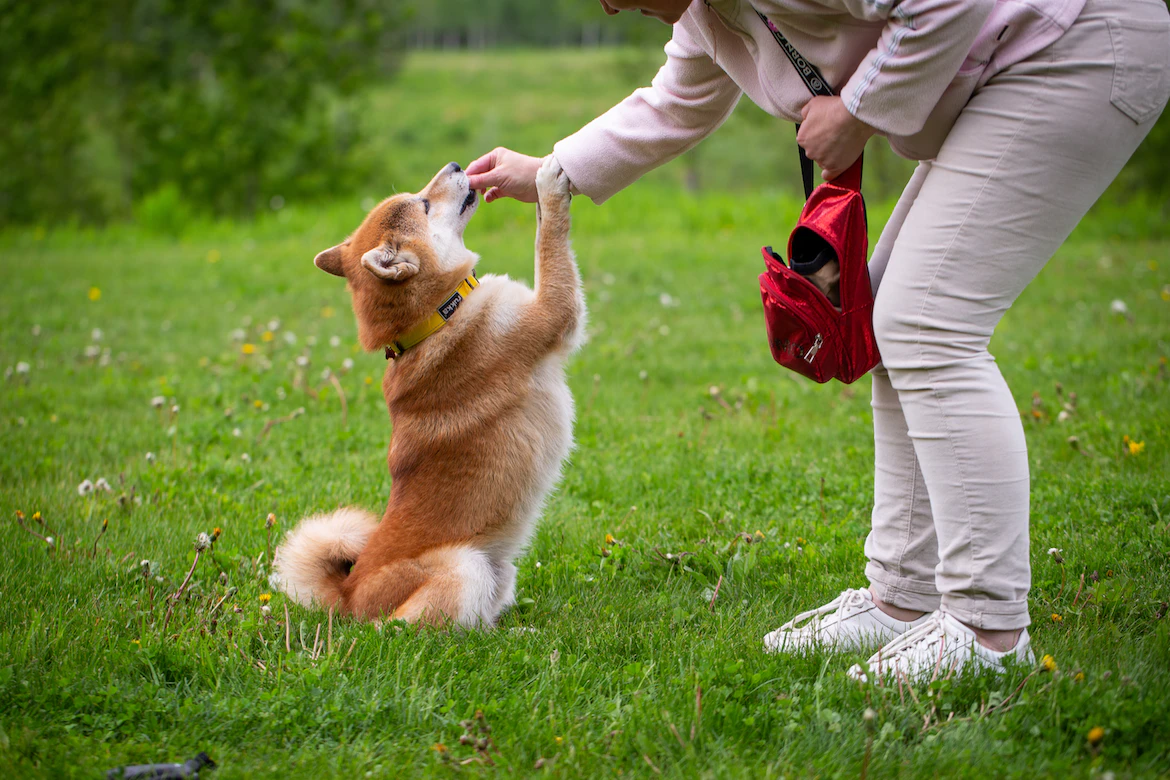‘Sit,’ ‘Stand,’ ‘Here,’ ‘Stay.’ You repeatedly keep commanding the dog, but all it does is ignore you. Such behavior can understandably be frustrating for the owner. But why does the dog behave so?
Is the dog purposely trying to irritate you? Has the dog suddenly decided to pick a bone with you and is being disrespectful? Is it being spiteful because you yelled at it that one time?
The answer is no to all these questions. Dogs are not capable of these complex emotions. They are simple creatures when it comes to their behavior. Their behaviors are much more dependent on the type of reaction they get.
For example, you ask the dog to ‘come’ and take it in for a bath or put it in the car and take it to the groomer or vet. For the dog, the command ‘come‘ may now mean something terrible will happen. So, it will stay away and not obey.
Distraction, lack of training and consistency, health issues, and stress could also be why your dog may not obey.
If you are in the ‘my dog doesn’t listen to me anymore’ phase, the article will explore the reasons for such behavior. We will also look at tips that may help to get the dog to listen to you.
My Dog Doesn’t Listen To Me Anymore – Possible Reasons
Understanding why your dog is ignoring you is the first step you can take. Please do not put all the blame for such behavior on your pet. If your dog does not listen, you must reassess your training techniques.
Here are possible reasons why your dog ignores you.
1. Your Dog’s Age Could be the Reason

It takes time for dogs to learn new commands and respond to them. The dog may understand the command in a couple of weeks. But, you must consistently reinforce the command for the dog to respond.
Puppies younger than three months old will be more receptive to your training. This is essentially their socialization period.
Training the dogs in the face of fear is challenging. Post the three-month mark, puppies become more aware of their environment. They may become skeptical and start developing fears.
In the canine world, the age from 6 to 18 months old is considered the adolescent period in dogs. This is when they become sexually mature and are ruled by their hormones. As a result, your dog may not listen to you because it is dealing with strong emotions.
Neutering or spaying the dog may help calm down its rebellious streak. The key would be to start with simple commands and train the dog in less distracting environments.
2. Your Commands are Difficult to Understand
Short and sweet – that is how your commands should be to the dog.
It is perfectly normal for you to talk to your dog, tell it stories, and tell it how much you love it. All pet owners do this. But talking to your dog and commanding your dog are two different things.
You may use clear, crisp language, but those grammatically correct sentences will not make sense to the dog. Instead, they will be more interested in the tone you use and your body language.
The most intelligent dogs on this planet have the IQ equivalent to that of a two-year-old baby. Such dogs can remember the names of a few hundred objects at best. They do not have the mental capacity to listen, process, and respond to complex language.
So, you need to set realistic expectations. For example, instead of saying, ‘please do not move; stay right there,’ use the command ‘stay.’
Bonus Read: How To Sedate A Dog For Grooming: A Concise Guide
3. You Are Not Consistent with Rules

The success of dog training depends on the dog and the human providing the training.
According to professional trainers, your dog may learn simple commands in a couple of weeks. But if you do not consistently enforce those commands in different environments, the dog will not completely absorb the training.
Also, all family members and friends interacting with the dog should be on board with training. For example, the dog jumps on top every time you lie down. You may be training the dog with commands like ‘get off and ‘stay.’
But other family members let the dog sleep on them and even rewarded the behavior with cuddles and kisses. Such inconsistent behavior confuses the dog.
So the next time you lay down, the dog will try to plop on you. And your commands to get off might get ignored.
4. Your Dog is Distracted
Your dog may listen to you when you are inside the house but may not be able to give you the same amount of attention when outside.
Your dog could be too distracted even to hear your commands in the first place. When their senses are overloaded with loud noises, vibrant sounds, and different smells, it can be difficult for them to concentrate.
You can, of course, train the dog to get over distractions, but that, again, requires patience and practice.
The dog may respond well to simple dog food when inside the house. But when outside in a fun environment like a dog park, it may find more tempting things to explore than dog food, especially if it is fully satiated.
Simple cues, high-value treats, and gradual resistance to distractions would be the way to go. More on that later.
5. Your Dog is Averse to Certain Commands

As we mentioned above, your dog’s behavior is dependent on the type of result it gets. If a positive experience follows a command, the dog will happily listen to you. If a negative experience follows a command, the dog will show hesitancy and remain rooted in its place.
For example, you return home, call the dog by its name, use commands like ‘come here,’ and engulf the dog in a big bear hug. Then, you reward it with hugs and kisses. This is a positive experience.
Other times you use the command ‘come here and take the dog to the groomer. The trip to the groomer could be stressful if your dog does not like to take a bath or get its nails trimmed.
Now the dog is confused about what the command ‘come here’ means. Will it be a reward or punishment? So it will hesitate to comply with your commands, making you despair – my dog doesn’t listen to me anymore.
6. Your Dog is Dealing with Strong Emotions
Canines are capable of feeling emotions. Complex emotions like pride or guilt will not register on their radar. But your dog can feel basic emotions like love, joy, anger, fear, anxiety, excitement, shyness, and distress.
Depending on the situation, these emotions can be pretty solid and overwhelming for the pet to handle. So the dog may involuntarily end up ignoring you.
For example, if your dog gets stressed in the company of other dogs, forcing it into a playdate with four other dogs will not be a good idea. The dog may get scared and focus all its energy on protecting itself.
Expecting the dog to listen to your commands in such a stressful situation is unrealistic.
Alternatively, suppose the dog is too happy bouncing around with your children. In that case, it might take a few tries before you catch your dog’s attention.
7. You are Dealing with Poisoned Cues

A cue can be a verbal or physical signal for the dog to behave a certain way. For example, you use the command, ‘drop it,’ and expect the dog to drop whatever it holds.
A cue becomes poisoned when its meaning is all but lost on the dog. This can happen due to improper training techniques. The dog did not understand the cue in the first place, or it was not reinforced enough to register.
For example, let us take the simple cue ‘sit.’ You have taught the dog to sit still when you say the word ‘sit.’ But other family members do not enforce the cue as strictly as you do.
You may be firm with the command and not reward the dog until it displays the expected behavior. On the other hand, your partner or children may cave in and pamper the dog even when it does not show typical behavior.
So the cue, ‘sit,’ has lost its meaning. As a result, you may find yourself repeating the cue multiple times before the dog complies, or it may ignore you altogether.
Thus, you must be patient and let the dog absorb the training.
8. You Are Brutal with Training
Dogs typically have an attention span of 15 to 30 minutes. In the case of puppies and highly energetic breeds like Labrador Retrievers and Siberian Huskies, their attention spans could be much shorter.
If you keep training the dog for hours, your efforts will be futile. The dog will get bored and frustrated and unable to grasp anything you say after a point. So, your training sessions have to be planned accordingly.
This, in turn, can be frustrating for you, and you may become annoyed and angry. You may shout and yell. Dogs can pick on their owners’ emotions. They do not want to be on the receiving end of their owners’ anger.
So, if you find the dog sniffing the ground, looking elsewhere, or avoiding eye contact, it is just trying to keep the peace.
9. Your dog Cannot Hear

If your dog used to respond to your commands but has suddenly started ignoring you, the reason could be an issue with the dog’s hearing sense.
One such issue could be a ruptured eardrum. Your dog’s eardrum is a thin membrane that separates its middle and inner ear from the outer canal. Any damage to the membrane can result in temporary hearing loss.
So, in this case, the dog is not ignoring you; it simply cannot hear you.
The possible causes of ruptured eardrums include middle ear infections, injury, the presence of foreign objects, and loud noises, among others.
The dog may show additional symptoms like head tilting, incoordination, eyes darting back and forth, and inflamed ear canal.
Once the cause is identified and the dog receives treatment, it should also get back its hearing sense. Without surgery, ruptured eardrums can heal in about five to six weeks.
10. Your Dog Could Be in Pain
Dogs can develop several health conditions that may not have visible symptoms. For example, the dog could be in pain, but it may do a good job of hiding it. Instead, the dog may refrain from doing activities that aggravate its situation.
If your well-trained dog suddenly starts ignoring you, an underlying health concern could be the problem.
For example, suppose the dog is in the initial stages of developing joint pain. In that case, it may eat, play well, and be in its usual cheerful mood. But, you may notice its hesitancy when your commands involve running around the yard or climbing up a flight of stairs.
In such cases, you must carefully monitor the dog for other signs. Then, it would be best to discuss the pet’s condition with the vet.
11. The Behavior Could be Breed Specific
Some dog breeds are notoriously challenging to train. But the dogs are not purposely trying to offend or disobey you. Instead, their stubborn behavior could be linked to why the breeds were bred in the first place.
For example, the Afghan Hound is a breed specifically bred to course through the rough mountain terrain. Today, the breed is one of the most skilled hunters in the canine world.
The breed is loyal, but they are also independent. And once they lock onto a prey, it will be difficult to pull them away from the chase.
Another example is Rottweilers. They can become too protective and will listen only to their owners. Other stubborn dog breeds include Bullmastiffs, Basset Hounds, and Bulldogs.
It is not impossible to get these dogs to listen to you, but training them will require considerable time, effort, and patience.
How to Get Your Dog to Listen To You?
If you are struggling with the ‘my dog doesn’t listen to me anymore’ situation, here are tips that can help.
1. Get All Family Members Involved

If you do not want the dog to get confused with cues, all family members must be on board with the dog’s training. For example, if you are trying to get the dog to stop jumping on people, all members must stick to the cue, ‘get off or ‘no.’
If one member says no and another member pets the dog even when it does not listen, the cue loses meaning. Thus, members must assume equal responsibility for the dog’s training.
2. Stay Consistent with Training
If you want a habit or behavior to stick, you must practice it consistently. You need to be consistent if it is a new behavior you are trying to enforce, teach the dog a new trick or overcome bad behavior. The same goes for your pet.
For example, if you are teaching the dog not to beg for table scraps, then you should not feed it to table scraps in any situation. Just because the dog listened to you the first three times does not mean you reward it with table scraps the fourth time.
Such inconsistent behavior lays waste to all your efforts.
3. Be Gentle But Firm with Commands

Before the dog learns word association, your voice’s tone and volume affect it. It may not understand the cue yet, but it can distinguish the tone you use and mold its behavior accordingly.
For example, a high-volume and high-pitch tone are typically associated with cheerful cues. It shows you are happy. The dog may respond by wagging its tail or licking your face.
Similarly, a low-volume and low-pitch tone is the best way to get your dog’s attention. Using a firm tone shows the dog you mean business, and it better behaves appropriately.
4. Train the Dog to Ignore Distractions
Start training the dog inside the protected confines of the house. In the absence of distractions, the pet will quickly pick up what the cue means.
Next, use the same cue when other people are in the house. This will help the dog ignore what others are doing and focus on you.
Next, use the same cue outside in the front or backyard. The dog will learn to ignore people, car sounds, and other nearby animals in this environment.
When you gradually work through distractions, there are higher chances of the dog listening to you in social places and situations like the dog park.
5. Use High-Quality Treats

If you use low-value treats, your dog will not be motivated enough to listen to you. For example, the dog had a meal a couple of hours back; now, you are using the same kibble as a treat while training.
You can understand why the dog will not work extra hard for some kibble. Also, it could be the case that the undesirable activity or the distraction is more fun to engage with than the treat you offer.
Thus, using high-value treats like bully jerky, small pieces of lamb, chicken, bacon, liver, and bone treats can be more effective.
6. Address Rough Experiences
If your dog is averse to specific experiences, you must help it overcome its fear. For example, taking a bath, doing nail trimming, or going to the vet should not negatively impact the dog’s behavior.
For example, if your dog fears nail trimming, try to get it comfortable with you holding its paws. Techniques like speaking to the dog in a soothing voice, using nail grinders instead of clippers, and grinding one nail at a time can help.
If the dog is scared of getting into the car, let it sniff the car, sit inside, and you may start the vehicle without driving anywhere. Once it gets comfortable, you can drive around the block and gradually increase the distance.
7. Seek Professional Help

If you do not have time to train your dog, you can seek help from professional trainers. These trainers have experience dealing with different dog breeds, ages, personalities, and temperaments.
They may be able to avoid training issues that may not be obvious to you. In addition, they can prepare a customized training routine according to your pet’s needs.
Trainers can surely help, but you need to support them with consistent reinforcement at home.
8. See the Vet
If your well-behaved and well-trained dog suddenly starts ignoring you, visiting the vet would be best.
The vet will perform a thorough physical examination to determine what is wrong with the pet. The vet may conduct additional tests if the dog shows other signs like limping, change in gait, head tilting, lethargy, or loss of appetite.
Depending on the diagnosis, the vet may prescribe medication, surgery, or therapy to cure or manage the condition.
9. You Have to be Patient

Dogs are intelligent, but you need to set realistic expectations while training. If you push through the training, the dog may never fully grasp the teachings and fail to behave as expected.
Dogs trying to overcome fears and aversive training techniques need more time to learn. Likewise, adult dogs that were not socialized well or if they have a history of abuse and mistreatment need much more love and care.
What Should You Not Do When the Dog Does Not Listen To You?
At this point, we want to reiterate that when dogs do not listen to you, it is not a part of some malicious agenda toward you. Behind those puppy dog eyes, your pet is not scheming ways to annoy or anger you.
As we have seen above, the dog may not understand you, have difficulty dealing with its own emotions, or be suffering from a medical condition.
Please do not yell, pull on the dog’s leash or hit it. Such punishments do not work. Moreover, they can harm the relationship you share with the pet. Thus, in such situations, you should be patient.
Your dog may forget if you hit it once or twice. But, if you make it a habit, it will grow fearful of you. It may also get aggressive to protect itself.
Summary
If you are one of the many pet owners concerned, ‘my dog doesn’t listen to me anymore,’ know that there are several reasons for such behavior.
Your dog could still be in the training phase, or you may not be clear with commands or consistent with training. In addition, your dog could be distracted or dealing with strong emotions like fear or joy.
If your dog suddenly stops listening to you and displays additional symptoms, the cause could be a medical condition. Please see the vet in such cases.
Techniques like consistent training, addressing rough experiences, and using high-quality treats can help. If your dog is stubborn, you can seek help from professional trainers and behaviorists.
Elena Gherman is a highly skilled and knowledgeable animal care expert. At the start of her career, she gained practical expertise with multiple animals. In addition to that, she works as a DVM veterinary editor for Joy Pet Products, which focuses on offering reliable information on pet health and wellbeing. She meticulously reviews each piece of writing before it is published to make sure pet owners get the most precise and updated information possible.
